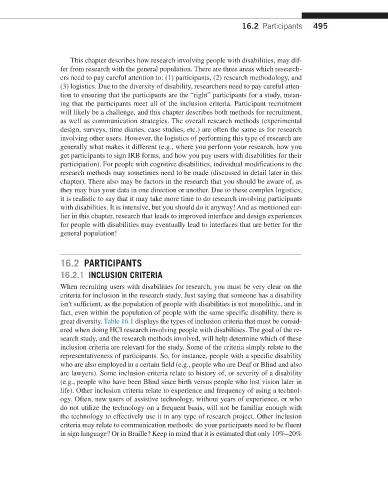Page 502 -
P. 502
16.2 Participants 495
This chapter describes how research involving people with disabilities, may dif-
fer from research with the general population. There are three areas which research-
ers need to pay careful attention to: (1) participants, (2) research methodology, and
(3) logistics. Due to the diversity of disability, researchers need to pay careful atten-
tion to ensuring that the participants are the “right” participants for a study, mean-
ing that the participants meet all of the inclusion criteria. Participant recruitment
will likely be a challenge, and this chapter describes both methods for recruitment,
as well as communication strategies. The overall research methods (experimental
design, surveys, time diaries, case studies, etc.) are often the same as for research
involving other users. However, the logistics of performing this type of research are
generally what makes it different (e.g., where you perform your research, how you
get participants to sign IRB forms, and how you pay users with disabilities for their
participation). For people with cognitive disabilities, individual modifications to the
research methods may sometimes need to be made (discussed in detail later in this
chapter). There also may be factors in the research that you should be aware of, as
they may bias your data in one direction or another. Due to these complex logistics,
it is realistic to say that it may take more time to do research involving participants
with disabilities. It is intensive, but you should do it anyway! And as mentioned ear-
lier in this chapter, research that leads to improved interface and design experiences
for people with disabilities may eventually lead to interfaces that are better for the
general population!
16.2 PARTICIPANTS
16.2.1 INCLUSION CRITERIA
When recruiting users with disabilities for research, you must be very clear on the
criteria for inclusion in the research study. Just saying that someone has a disability
isn't sufficient, as the population of people with disabilities is not monolithic, and in
fact, even within the population of people with the same specific disability, there is
great diversity. Table 16.1 displays the types of inclusion criteria that must be consid-
ered when doing HCI research involving people with disabilities. The goal of the re-
search study, and the research methods involved, will help determine which of these
inclusion criteria are relevant for the study. Some of the criteria simply relate to the
representativeness of participants. So, for instance, people with a specific disability
who are also employed in a certain field (e.g., people who are Deaf or Blind and also
are lawyers). Some inclusion criteria relate to history of, or severity of a disability
(e.g., people who have been Blind since birth versus people who lost vision later in
life). Other inclusion criteria relate to experience and frequency of using a technol-
ogy. Often, new users of assistive technology, without years of experience, or who
do not utilize the technology on a frequent basis, will not be familiar enough with
the technology to effectively use it in any type of research project. Other inclusion
criteria may relate to communication methods: do your participants need to be fluent
in sign language? Or in Braille? Keep in mind that it is estimated that only 10%–20%

